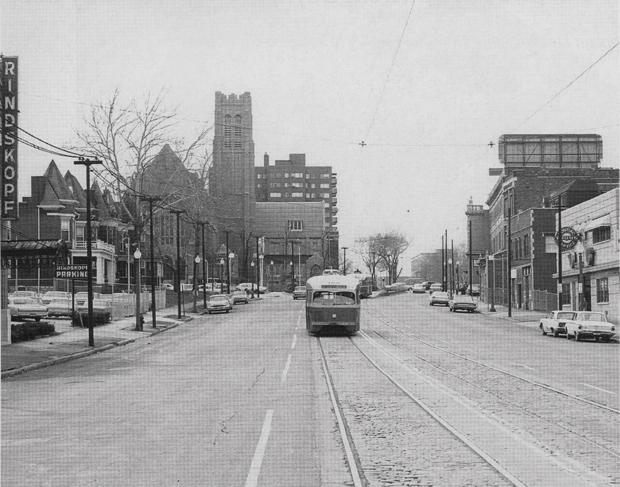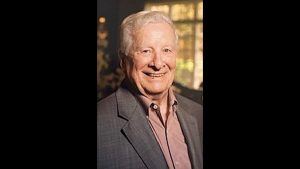Clang, Clang, Clang Went the Trolley!
Published June 14, 2012
Entrepreneur Joe Edwards, whose vision is responsible for Blueberry Hill, the Pageant and the Moonrise Hotel, and who helped ignite the Delmar Loop Renaissance, is making progress toward fulfillment of his latest dream: construction of a trolley system before 2013 that would link the Loop to Forest Park.
Like Edwards, those in favor of the project say it will boost tourism, help businesses and connect the lively Loop to Forest Park. But others, including some homeowners in the area, are concerned about the overheard wires used for the trolleys and their impact on property values. They have signed petitions to try to get the project killed or changed.
ADVERTISEMENT
However the Loop trolley project ultimately plays out, many members of the St. Louis Jewish community of a “certain age” will surely remember the days of the original boxy streetcars and the later “streamlined” yellow and red vehicles with fondness.
In 2002, Andrew D. Young, the first director of the St. Louis Jewish Archives, published a fantastic book, “Streets & Streetcars of St. Louis: A Sentimental Journey” (Archway Publishing, $39.95). This comprehensive volume is a nostalgic collection of more than 300 previously unpublished photographs of St. Louis and its streetcar suburbs, taken by local photographer Roy Gehl. The book displays hauntingly beautiful photos of St. Louis streetcars, primary covering the years 1946-1966, which Young says “brought immense changes to the city, especially in the inner ring of St. Louis suburbs, created by the streetcar.”
It is not by accident that two iconic musical and literary references to St. Louis trolleys and streetcars are familiar to millions: the song “Clang, Clang, Clang Went the Trolley” from “Meet Me in St. Louis,” and the title of former St. Louis resident Tennessee Williams most acclaimed play, “A Streetcar Named Desire.”
Like San Francisco, which restored its vintage trolley lines, and New Orleans, where “A Streetcar Named Desire” is set, St. Louis’s history, geography and demographics have been shaped in large part by the streetcar lines.
ADVERTISEMENT
In Young’s book, several chapters deal with Delmar, U. City, Kingsland, Vernon, Midland, plus Union/Pershing, DeBalieviere, University/Big Bend, Clayton, Easton Avenue (now Martin Luther King Avenue) and Wellston, “all Jewish residential/commercial areas within living memory,” he notes. St. Louisans in their sixties and older likely remember the smooth, quiet rides of the streetcars, which were much more graceful and comfortable than the lumbering, gas-guzzling buses that replaced them. Catching a streetcar in the Delmar Loop made it possible for U. City residents to go to midtown St. Louis to take in a movie at the Fox, Missouri or St. Louis theaters, enjoy a good meal along Olive Street and return in comfort—all for about 40 cents in carfare!
Young’s book shows photos of streetcars passing by the Rindskopf-Roth funeral home, the Jewish-owned Breiner’s Pastry Shop, Carl Klein’s Pharmacy, and the old pharmacy that was later taken over by Paul’s Books, a tremendous U. City landmark.
There is also a strong Jewish connection to the manufacturer of the actual street cars: the old St. Louis Car Company, which was headed by the late Edwin B. Meissner, Sr., who died at age 71 on Sept. 12, 1956. Meissner was president of the company, one of the nation’s largest manufacturers of railroad and light rail cars, and the St. Louis Aircraft Corporation. He was active for many years on the Jewish Federation Board of Directors, and served for over 20 years as President of Congregation Shaare Emeth.
The St. Louis Car Co., later known as General Steel Industries, manufactured not only St. Louis streetcars and trolleys but cars for such far-flung transit systems as the Metro in Paris, France. Meissner’s son, Edwin B. Meissner, Jr., succeeded his father as head of the company, and continues to be an active member of Congregation Shaare Emeth.
Streetcars held sway in St. Louis and its suburbs from the 1880s until the mid- and late 1940s. Young records that new state-of-the-art buses began to encroach on the streetcars domain. New streamlined streetcars were brought into service in 1946 to replace older cars, some dating back to 1903. (Edwards plans to use vintage, pre-streamlined cars for his Forest Park-U. City Loop trolley). By 1947, with the removal of eight lines, only a little more than half of the original streetcar system remained.
The advent of early home TV-watching also cut down the ridership. Still, some streetcars continued to roll into the early 1960s until the St. Louis Public Service Company sold all of its St. Louis properties for $20 million to the Bi-State Development Agency as of April 1, 1963. Another 14 other local transit companies were also sold to Bi-State for another $5 million, with the whole package funded by a bond issue. The old streetcars were phased out by Bi-State, with the last car running in 1966.
And so, the end of the streetcar era may soon be replaced by a partial re-birth of that wonderful mode of transportation through Edwards’ vision. At a recent public hearing, a former U. City Council member, Elsie Beck Glickert, was recently quoted in the West End Word as having praised Edwards, then added: “Joe, you’re a visionary but frankly this is a streetcar named no desire. . . to no destination.”
While we agree that Edwards is indeed a visionary, we respectfully disagree with Ms. Glickert on the latter part of her statement. For this St. Louis Jew and others, there is “desire” to see Edwards’ plan succeed!
















